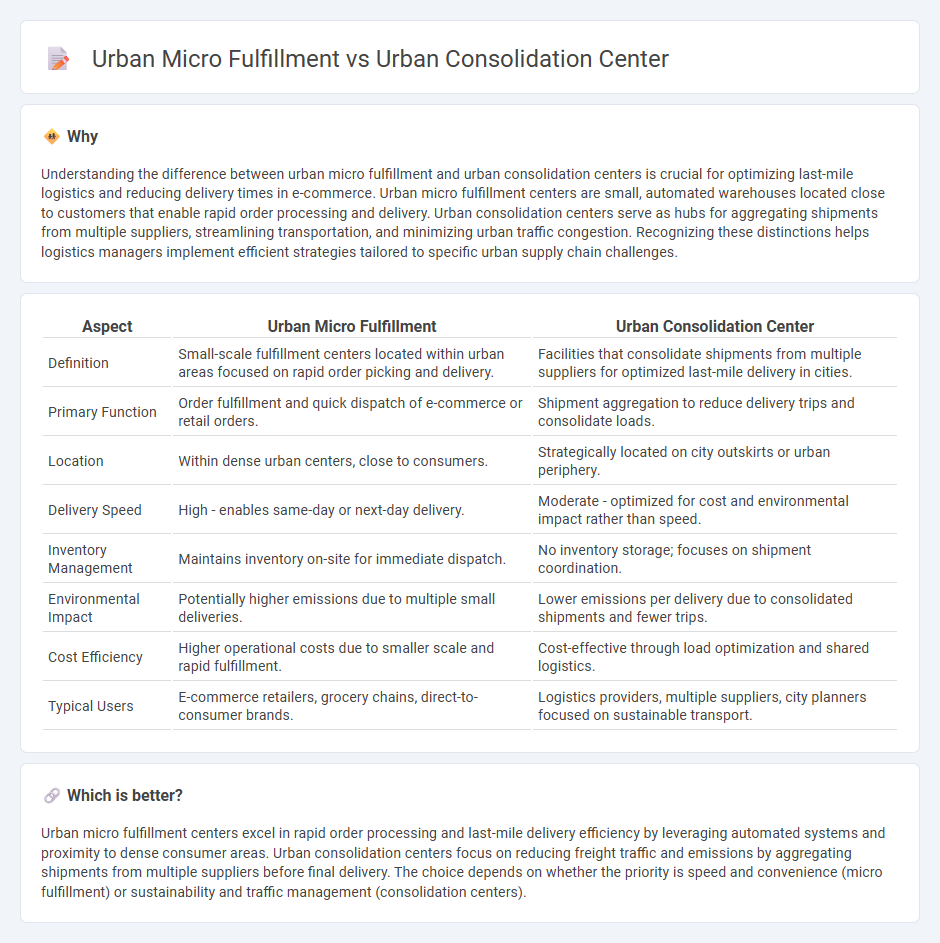
Urban micro fulfillment centers (MFCs) focus on rapid order preparation within city limits to meet growing e-commerce demand by utilizing automated systems and limited space. Urban consolidation centers (UCCs) optimize last-mile delivery by aggregating shipments from multiple suppliers to reduce traffic congestion and emissions. Explore the benefits and applications of both strategies to enhance urban logistics efficiency.
Why it is important
Understanding the difference between urban micro fulfillment and urban consolidation centers is crucial for optimizing last-mile logistics and reducing delivery times in e-commerce. Urban micro fulfillment centers are small, automated warehouses located close to customers that enable rapid order processing and delivery. Urban consolidation centers serve as hubs for aggregating shipments from multiple suppliers, streamlining transportation, and minimizing urban traffic congestion. Recognizing these distinctions helps logistics managers implement efficient strategies tailored to specific urban supply chain challenges.
Comparison Table
| Aspect | Urban Micro Fulfillment | Urban Consolidation Center |
|---|---|---|
| Definition | Small-scale fulfillment centers located within urban areas focused on rapid order picking and delivery. | Facilities that consolidate shipments from multiple suppliers for optimized last-mile delivery in cities. |
| Primary Function | Order fulfillment and quick dispatch of e-commerce or retail orders. | Shipment aggregation to reduce delivery trips and consolidate loads. |
| Location | Within dense urban centers, close to consumers. | Strategically located on city outskirts or urban periphery. |
| Delivery Speed | High - enables same-day or next-day delivery. | Moderate - optimized for cost and environmental impact rather than speed. |
| Inventory Management | Maintains inventory on-site for immediate dispatch. | No inventory storage; focuses on shipment coordination. |
| Environmental Impact | Potentially higher emissions due to multiple small deliveries. | Lower emissions per delivery due to consolidated shipments and fewer trips. |
| Cost Efficiency | Higher operational costs due to smaller scale and rapid fulfillment. | Cost-effective through load optimization and shared logistics. |
| Typical Users | E-commerce retailers, grocery chains, direct-to-consumer brands. | Logistics providers, multiple suppliers, city planners focused on sustainable transport. |
Which is better?
Urban micro fulfillment centers excel in rapid order processing and last-mile delivery efficiency by leveraging automated systems and proximity to dense consumer areas. Urban consolidation centers focus on reducing freight traffic and emissions by aggregating shipments from multiple suppliers before final delivery. The choice depends on whether the priority is speed and convenience (micro fulfillment) or sustainability and traffic management (consolidation centers).
Connection
Urban micro fulfillment centers and urban consolidation centers are interconnected components in modern logistics designed to enhance last-mile delivery efficiency. Micro fulfillment centers focus on rapid order picking and packing close to consumers, while consolidation centers aggregate shipments from multiple sources to optimize delivery routes and reduce transportation costs. Together, they streamline inventory management and distribution in dense urban environments, minimizing delivery times and environmental impact.
Key Terms
**Urban Consolidation Center:**
Urban Consolidation Centers (UCCs) streamline last-mile delivery by centralizing goods from multiple suppliers into a single distribution point, reducing traffic congestion and carbon emissions in dense urban areas. UCCs improve logistics efficiency through optimized route planning and consolidated shipments, lowering delivery costs and environmental impact. Explore further to understand how Urban Consolidation Centers revolutionize sustainable urban logistics.
Freight Aggregation
Urban consolidation centers (UCCs) focus on freight aggregation by centralizing deliveries to reduce traffic congestion and improve last-mile efficiency, typically handling large volumes of goods for various retailers. Urban micro fulfillment centers (UMFCs) prioritize rapid order processing within localized hubs, leveraging automation for speed but with less emphasis on extensive freight aggregation. Explore how integrating both UCCs and UMFCs can optimize urban logistics and enhance sustainable freight strategies.
Last-Mile Delivery
Urban consolidation centers (UCCs) optimize last-mile delivery by centralizing shipments from multiple suppliers, reducing traffic congestion and emissions through fewer delivery vehicles. Urban micro-fulfillment centers (UMFCs) enhance speed and efficiency by positioning small-scale warehouses within city limits, enabling faster order processing and same-day delivery. Explore in-depth insights on how UCCs and UMFCs reshape urban logistics for superior last-mile solutions.
Source and External Links
Urban consolidation centers - a solution for improved and sustainable city logistics - Urban consolidation centers (UCCs) are strategically located facilities where goods are collected, sorted, and consolidated before final delivery within cities, helping reduce traffic and emissions by using smaller vehicles for last-mile delivery.
Advancing City Logistics and Sustainability with Urban Consolidation Center - UCCs consolidate deliveries from multiple vendors into fewer, smaller trucks near urban areas, which can reduce fleet size by 60% to 80%, ease congestion, and contribute to sustainability goals through fewer vehicle miles and off-peak deliveries.
Urban Consolidation Centers: The Good, The Bad, and the Ugly-The Dutch Experience - UCCs have been studied in the Netherlands for their role in efficient and environmentally friendly urban freight transport, relying heavily on public-private partnerships and stakeholder collaboration for success.
 dowidth.com
dowidth.com